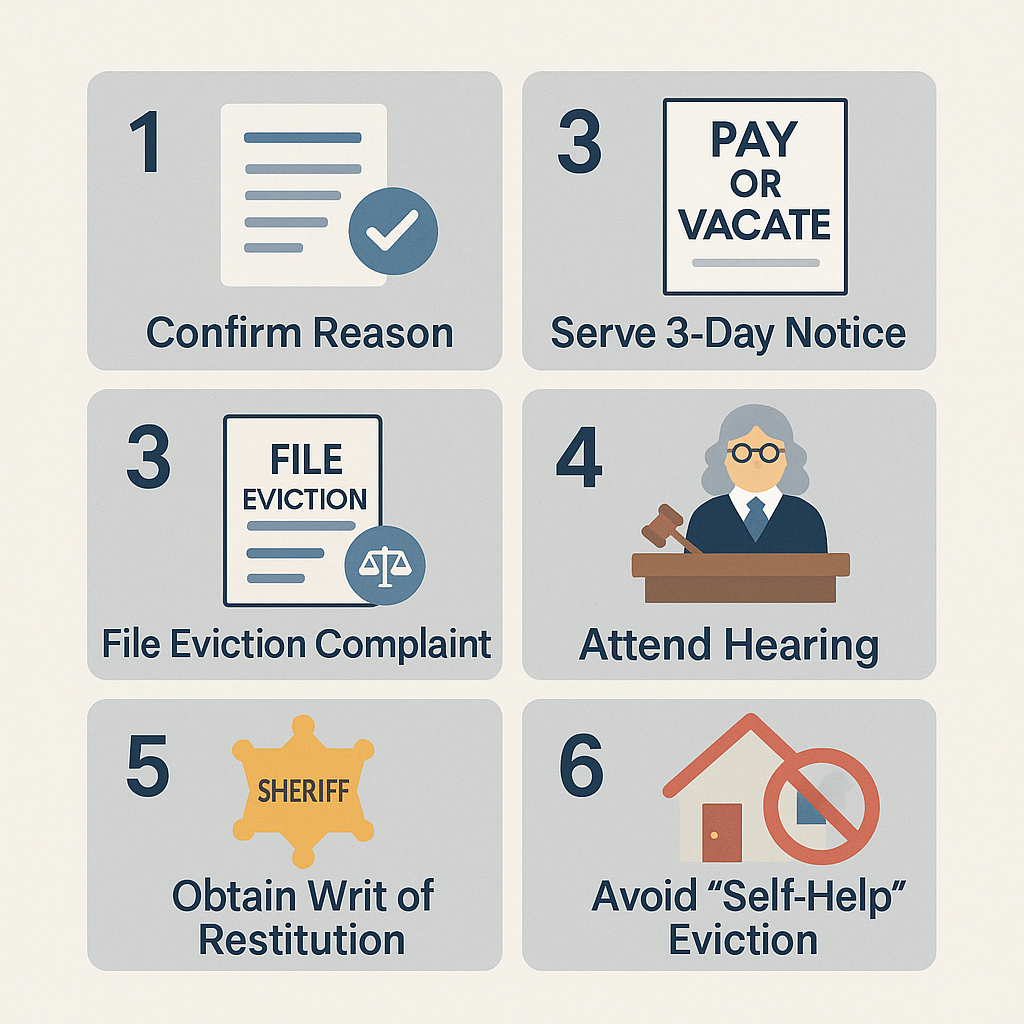How do Utah landlords evict for nonpayment (step-by-step)?
Plain-English guide to notices, filings, hearings, and writs to stay compliant and avoid costly mistakes
If a tenant stops paying rent in Utah, you cannot change the locks or shut off utilities. The law gives landlords a clear process to follow starting with a notice, moving through court filings, and ending if needed with the sheriff. This guide breaks that down step by step so you can stay compliant and avoid costly mistakes.
Confirm the Reason and Gather Documentation
Before doing anything, make sure the missed payment is clear and documented. Save rent ledgers, the lease, and any text or email communications about payment. You will need these if the tenant disputes the eviction. Courts expect accurate records showing that rent was not paid and when it became overdue.
Checklist:
- Lease copy and payment record
- Communication proof such as texts or emails
- Tenant contact information
- Amounts and due dates of unpaid rent
Serve a 3-Day Notice to Pay or Vacate
Utah law (Utah Code §78B-6-802) requires written notice before filing an eviction. For nonpayment, use a 3-Day Notice to Pay or Vacate. It must clearly state how much is owed, where to pay, and that eviction will follow if payment is not made.
You can serve the notice by:
- Personal delivery to the tenant
- Posting in a visible spot on the property and mailing a copy
- Using a process server
Checklist:
- Use the official 3-Day Notice to Pay or Vacate form
- Include full payment details such as amount and where to pay
- Keep proof of service such as photos, receipts, or a process server affidavit
File an Eviction (Unlawful Detainer) Complaint
If the tenant does not comply after 3 days, file an unlawful detainer complaint in the proper Utah Justice Court or District Court. Attach your documentation and proof of notice service. The court will issue a summons, which must be served on the tenant. Most cases start in Justice Court and move quickly. You can often request a prompt hearing.
Checklist:
- File complaint and summons with the court
- Pay the filing fee
- Serve the summons properly
- Wait for the tenant response window to pass, usually 3-7 days
Attend the Hearing and Present Evidence
If the tenant answers or disputes the case, the court will schedule a hearing. Bring the lease, payment record, notices, and any messages or photos tied to nonpayment. The judge decides whether you regain possession or the tenant can stay. If the tenant does not appear or respond, you may get a default judgment for possession.
Checklist:
- Organize all evidence clearly
- Bring proof of unpaid rent and communication
- Be prepared to state facts calmly and directly
- Review court landlord-tenant materials before the hearing
Obtain a Writ of Restitution
If you win, request a Writ of Restitution. This authorizes the sheriff or constable to remove the tenant. Do not perform the lockout yourself. Law enforcement will handle the physical eviction, often within a few days.
Checklist:
- Request the writ after judgment
- Coordinate with local law enforcement
- Wait for official notice that possession is returned
Avoid Illegal Self-Help Evictions
Even if you are frustrated, do not change locks, cut off power, or remove belongings yourself. These actions can trigger penalties or legal claims against you. Always let the court and sheriff handle possession transfers.
Checklist:
- Never lock out a tenant without a writ
- Never remove property without law enforcement direction
- Document every step to protect yourself
Recover Unpaid Rent with a Separate Claim
After you regain possession, you may still be owed rent or damages. If those amounts were not included in the eviction judgment, file a separate small claims or civil case to recover money.
Checklist:
- Calculate total unpaid rent and any property damage
- Gather invoices and repair costs
- File a small claims case if needed
Key Takeaways
Use a proper 3-Day Notice to Pay or Vacate before you file anything.
File unlawful detainer in the correct court and serve the summons properly.
Do not self-help. Only a Writ of Restitution lets law enforcement perform the lockout.
Keep clean records from day one. Good documentation wins or loses these cases.
Video & Social Learning Hub
YouTube: Utah Eviction Process
Instagram: Utah Landlord – Tenant Highlights
Need Help Applying This to Your Property?
Each case is fact specific. If you are unsure about timing, service, or what to file, a quick consult with a Utah landlord – tenant attorney can prevent costly mistakes.
Talk to a Utah AttorneyFor more plain-English legal guidance, stay updated with Utah Law Explained, explore our mission on the About Us page, or connect with trusted counsel like Gibb Law Firm.
